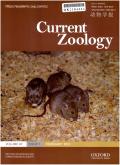螯虾Faxonius virilis种群内的体色变化与繁殖季节有关
IF 2
2区 生物学
Q2 ZOOLOGY
引用次数: 0
摘要
动物着色具有广泛的生物功能,可能受到不同的选择压力,有时甚至是相互冲突的选择压力。在甲壳类动物中,尽管颜色和颜色模式的范围很广,包括多层次的变异,但颜色的进化却相对缺乏研究。已知淡水小龙虾在种内和种群中表现出颜色变异以及个体内变异,但小龙虾颜色的功能(如果有的话)在很大程度上是未知的。在此,我报告了一项了解螯虾Faxonius virilis颜色变异模式的实验,结果表明这种变异与从夏季非生殖型到秋季生殖型的本体变化密切相关。螯虾在非生殖期的个体间和个体内的颜色变异相对较小,但在生殖期的个体间和个体内的颜色变异都很大。过渡到生殖形态与部分个体螯部颜色变绿或变蓝有关,但这些变化与性别或体型没有明显的相关性。未来的研究应侧重于确定交配季节个体之间的颜色差异是否与生理或行为差异或对捕食的易感性差异有关。本文章由计算机程序翻译,如有差异,请以英文原文为准。
Intrapopulation variability in coloration is associated with reproductive season in the crayfish Faxonius virilis
Animal coloration has a wide range of biological functions and may be subject to different, sometimes conflicting, selective pressures. In crustaceans, the evolution of coloration is relatively unstudied, despite the broad range of colors and color patterns, which includes variability at multiple levels. Freshwater crayfish are known to show color variability within species and populations, as well as intra-individual variability, but the function, if any, of crayfish coloration is largely unknown. Here, I report on an experiment to understand patterns of color variability in the crayfish Faxonius virilis and show that variation is strongly correlated to ontogenetic changes from a summer non-reproductive form to a fall reproductive form. Crayfish showed comparatively little inter- and intra-individual color variation in their non-reproductive form, but substantial variation at both levels in the reproductive form. Transition to the reproductive form was associated with the development of greener or bluer coloration localized to the chelae on a subset of individuals, but these changes showed no clear correlation with sex or body size. Future investigations should focus on determining whether differences in color between individuals in the mating season are associated with any physiological or behavioral differences, or with differential susceptibility to predation.
求助全文
通过发布文献求助,成功后即可免费获取论文全文。
去求助
来源期刊

Current Zoology
Agricultural and Biological Sciences-Animal Science and Zoology
CiteScore
3.20
自引率
9.10%
发文量
111
审稿时长
6 weeks
期刊介绍:
About the Journal
Current Zoology (formerly Acta Zoologica Sinica, founded in 1935) is an open access, bimonthly, peer-reviewed international journal of zoology. It publishes review articles and research papers in the fields of ecology, evolution and behaviour.
Current Zoology is sponsored by Institute of Zoology, Chinese Academy of Sciences, along with the China Zoological Society.
 求助内容:
求助内容: 应助结果提醒方式:
应助结果提醒方式:


